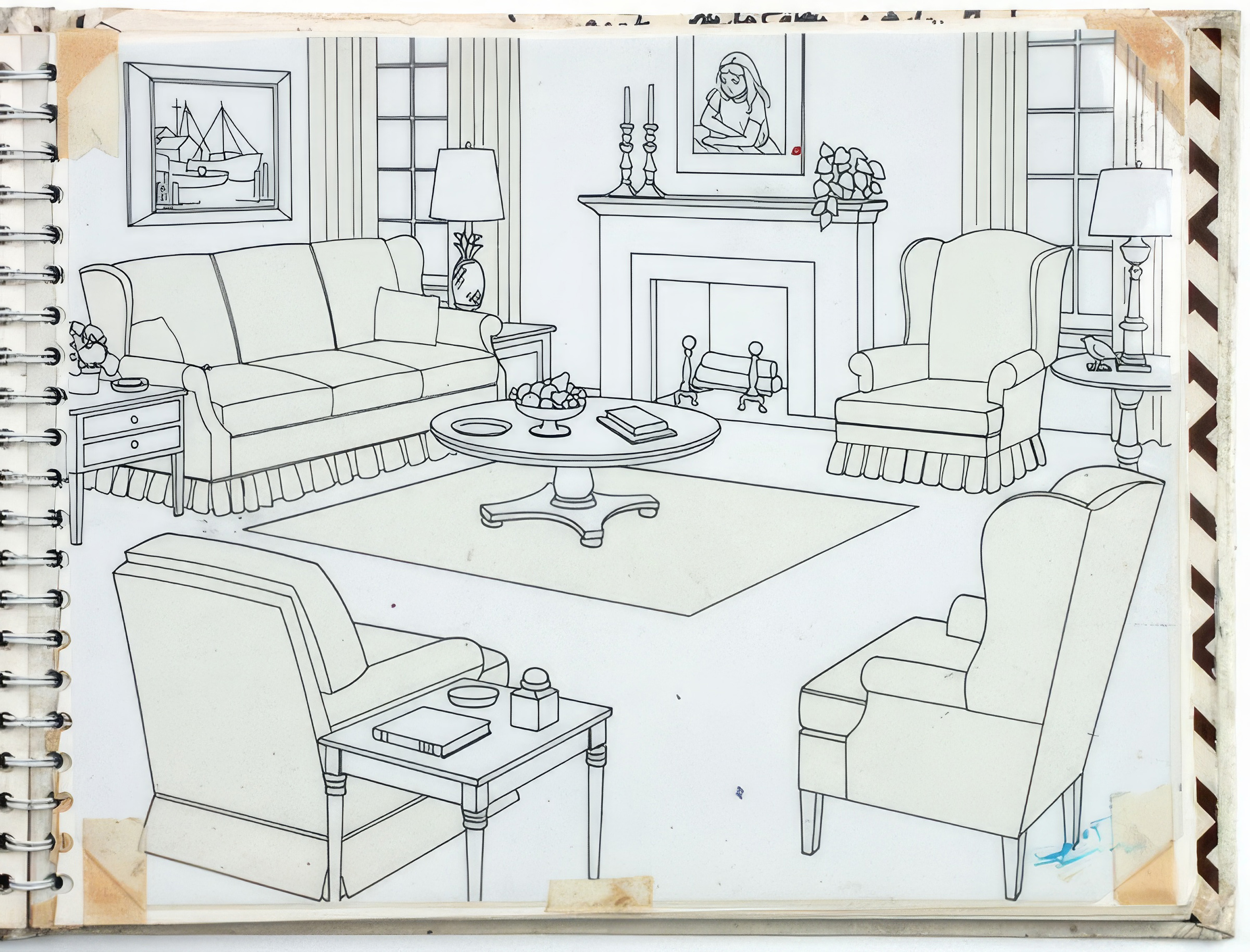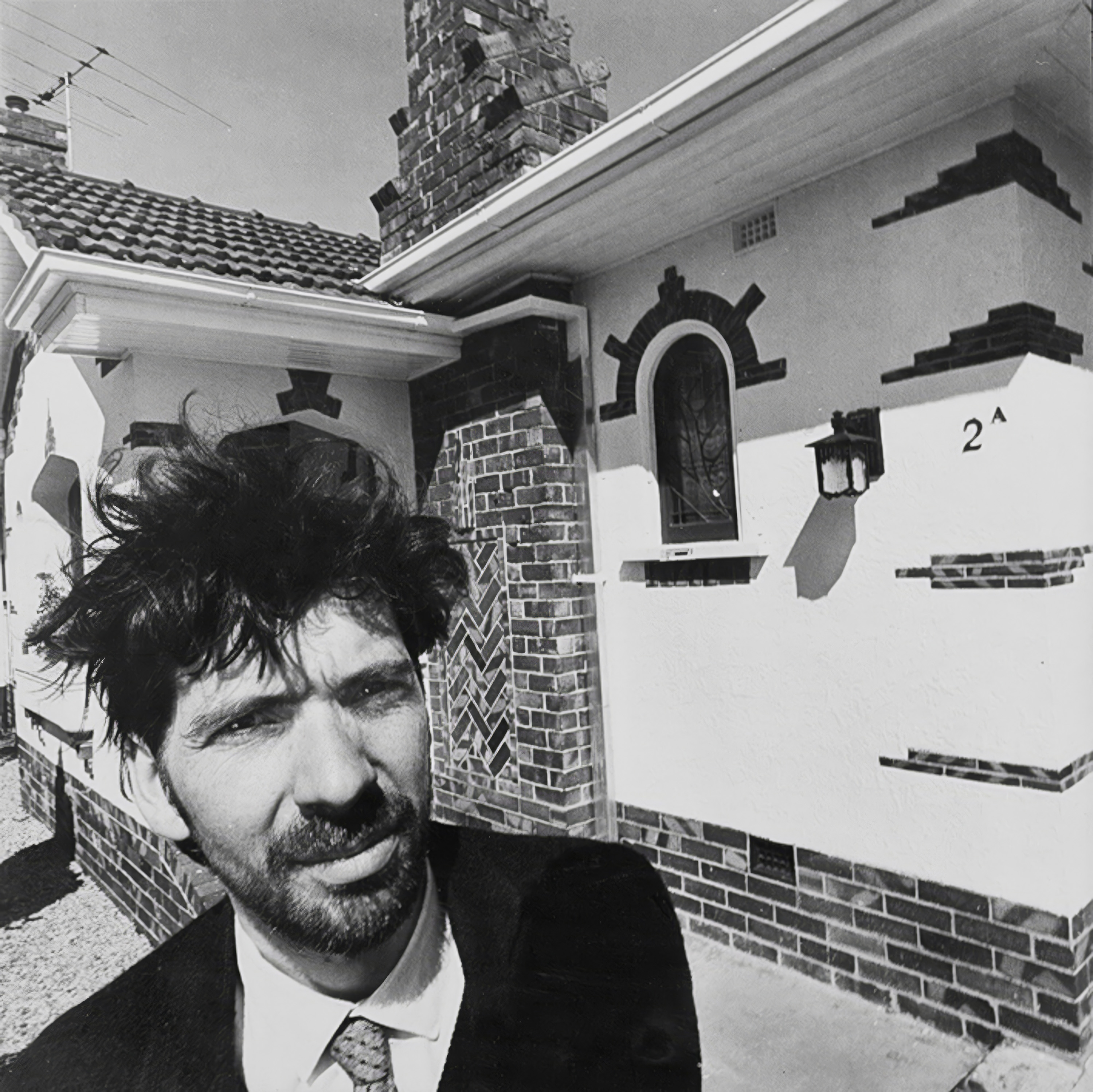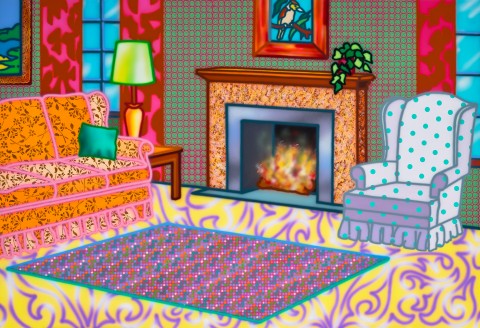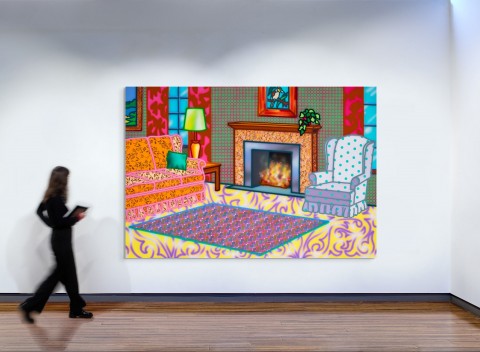NEAPOLITAN DELIGHT, 1993
HOWARD ARKLEY
synthetic polymer paint on canvas
172.5 x 254.0 cm
signed and dated verso: Howard Arkley 93
signed, dated and inscribed with title verso: Howard Arkley / Neapolitan Delight / 1993
Tolarno Galleries, Melbourne
The Sigg Collection, Switzerland, acquired from the above in April 1994
Arkley, H., and Humphries, B., Imaginary Australia, Arkitekturtidsskrift B, Denmark, no. 52+53, 1995, pp. 95 – 99 (illus.)
Howard Arkley Online Catalogue Raisonné:
[https://www.arkleyworks.com/blog/2009/12/08/neapolitan–delight–1993–lounge–room/] (accessed March 2025)
250112 Arkley-(cleaned up).jpg

Howard Arkley first exhibited a painting of the exterior of a suburban house in 19831, but this celebrated aspect of his oeuvre did not build momentum until the mid-1980s, culminating in the artist’s highly successful representation of Australia at the Venice Biennale in 1999 with his exhibition The Home Show. However, even at this nascent stage of his exploration of the subject matter that was to preoccupy him well into the next decade, the work arrived confident and fully formed; a riotous combination of the artist’s characteristic thick black linework, bold colour and all-over patterning. Tellingly, this exterior was exhibited alongside two works that dared to venture beyond the front gate, exploring the interiors of Arkley’s ‘suburban dreaming’2 with their cramped spaces, competing decoration and patterning, and unsettling, slightly wonky perspectives.3 From the outset, Arkley’s imagination was sparked not only by the instantly recognisable facades of the houses that line our suburban streets, but also, by what goes on within them. Yet rather than look at interpersonal dynamics and familial relationships, the artist explores the ‘private self’ through the way in which we choose to decorate our homes. For Arkley, these familiar interiors become investigative sites that enable him to playfully explore notions of aspiration and taste, together with the push-pull allure of suburban domesticity.
Arkley’s love of decoration and patterning was deeply connected to Australian suburbia, beginning as far back as 1978 with his photographic documentation of Australian flywire screen doors. Arkley and his first wife, artist Elizabeth Gower, had recently returned from travel in Europe and New York, where they had enthusiastically analysed and sketched the patterns they had encountered ‘in everything from the Paris railway station and linoleum, to Japanese prints and the paintings of Alfred Jensen and Henri Matisse.’4 However, for Arkley, it was these homegrown versions of Paris’ Art Deco and Art Nouveau grilles, gates and doorways that were to have the most influence, making their way at the time into his elegant black and white abstract paintings as decorative flourishes and repeated forms. As the artist explained:
‘…on return [from overseas] the provincial Australian wrought iron fly-wire security door dominated my attention. I used the door format to arrive at my canvas proportion using what turned out to be unlimited variations of pattern and shapes… subject allowed me to produce non-figurative images of a nature that not many viewers would relate to; a common, shared, visual source.’5
As the extensive holdings of the State Library of Victoria’s substantial Howard Arkley Archive demonstrate, Arkley was a prodigious collector of references and material scavenged from both high- and low-brow sources. Images from real estate advertising and interior decoration magazines were a vital wellspring for the artist’s suburban imagery, just as the artist’s own photographs, collages, doodles and notes served as the creative fuel for the asynchronous juxtaposition of his works’ richly patterned surfaces. Arkley’s suburban exteriors can in many instances be directly correlated to the real estate advertising and schematic images of houses that filled his visual diaries (enriched by his own forays into the suburbs to take photographs). By contrast, the early interiors were often the outcome of the artist’s creative imagination; amalgamations of different materials, surfaces and products selected from magazines and advertising as if purchased as individual items from a catalogue and carefully brought together to create the ‘perfect’ home. As Arkley has said of the creation of one such work:
‘The images in the painting came from a Myer direct mail catalogue, which I collaged together selecting all the elements that I really liked, those items which I thought were the best: the best carpet, the best light, the best chair plus a domestic pet…’6
250112 Arkley (enlarged).jpg

However, like many of the interiors from 1992 onwards, the composition of Neapolitan delight, 1993 is closely based on an identifiable source: the 1976 US publication The Instant Decorator by Frances Joslin Gold, which was given to Arkley by fellow artist (and occasional collaborator) John Nixon, who had found it in an op shop.7 In an echoing of Arkley’s own techniques in terms of pattern and decoration, the book featured transparent sheets over each outlined interior so that the homemaker could place fabric swatches and colour samples underneath to test their effect. From this time, Arkley’s interiors were not based on local sources at all, but instead derived from international architecture and design publications, such as the Italian magazine Domus, and his own extensive library, which included books ‘on Russian Constructivist design, the de Stijl movement, the Bauhaus, Marcel Breuer’s furniture, and contemporary Italian design.’8 The use of the Gold source, and the ability it provided (by simply turning the page) to effectively glide from one room to the next, is replicated in the both the visual and physical experience of Arkley’s ambitious environment Fabricated Rooms, 1997 – 99 – a work that effectively collages Gold’s elegant but vacuous templates into a show home full of awkward juxtapositions and strange, unsettling angles. First exhibited at the Art Gallery of New South Wales in late 1997, and then at Benalla Regional Art Gallery in April 1998, the installation’s original thirteen panels were later expanded to seventeen so that the work could assume the role of centrepiece in Arkley’s solo exhibition in Venice.9 Arkley’s work has always drawn comparison to American and British Pop artists Roy Lichtenstein (1923 – 1997) and Patrick Caulfield (1936 – 2005), to name but a few, but both the ambition and sheer expanse of Fabricated Rooms has its closest international parallel in James Rosenquist’s masterwork F-111, 1964 – 65 which Arkley saw for the first time in the exhibition High and Low: Modern Art and Popular Culture at the Museum of Modern Art, New York in 1991.10
Arkley’s ability to manipulate his everyday source material is clearly demonstrated by the way in which he dramatically crops the ‘original’ image for Neapolitan delight, slicing the couch and the painting above it in half while zooming in to focus his composition on the fire burning within the hearth. The kookaburra painting on the wall may place the interior with the realm of Australian suburbia, but the stuffy furniture design and its kitschy decoration speaks, as the work’s title suggests, of a kind of translation of continental ‘good’ taste that could be witnessed for decades in the houses of European immigrants of the 1950s and 60s (exemplified by the excessive, neo-Baroque furniture of Melbourne’s iconic Franco Cozzo). One can also assume that Arkley would have relished the double entendre of the painting’s title and its reference to Neapolitan ice cream, with its stripes of pink (strawberry), white (vanilla) and brown (chocolate). Arkley’s lounge room is the ‘best room’ – kept for company, and rarely in use, but his knowing juxtaposition of discordant colour and pattern are more Pop psychedelia than ‘good’ taste, creating an all-consuming environment that would prompt any suburban housewife to have ‘a cup of tea, a Bex and a good lie down.’11
By the early 1990s, Arkley was at the height of his powers, particularly when it came to his skill with the airbrush – his tool of choice. The artist’s signature black lines have disappeared in Neapolitan delight, replaced by a complex scheme of coloured outlines that both contrast and clash with the jostling array of colours and patterns that are barely contained within them. However, Arkley’s creation of a joyous kitsch wonderland – with its competing dots, moiré flourishes and plaid – is more indifferent than critical, and it remains difficult, within this work and others, to ascertain his attitude to the suburbs:
‘I don’t know… it’s a kind of love-hate thing. I love it [i.e. this type of suburban interior], but I wouldn’t want to live in it… You see photographs of rooms and you think, ‘My God, how do they live in that?’’12
Arkley recognised that life in the suburbs was the reality of most Australians, and he knew them from firsthand experience, having grown up in the eastern Melbourne suburb of Surrey Hills (which was also the home of artist John Brack, another Australian artist preoccupied by the suburbs). He was to make a return in 1991, moving to the outer Melbourne suburb of Caulfield with his partner Alison Burton. This ‘new’ environment also coincided with an increasing focus, between 1992 and 1994, on lavish suburban interiors like Neapolitan delight.
The international reach of Arkley’s art is evidenced by this work’s acquisition in 1994 for the Sigg Collection, Switzerland, well before the artist’s representation in Venice further catapulted his art world success. At the time of the work’s purchase, businessman and diplomat Uli Sigg had amassed one of the world’s largest collections of contemporary Chinese art. After its donation in 2012, the Sigg Collection formed the basis of the burgeoning collection of Hong Kong’s M+ prior to the museum’s long-awaited opening in 2021.
1. Howard Arkley, Suburban exterior, 1983. This painting was first exhibited in the exhibition Howard Arkley: Urban Paintings at Tolarno Galleries, South Yarra, 22 October – 13 November 1983, see Gregory, J., ‘Suburban exterior (1983)’, Arkley Works, at: https://www.arkleyworks.com/blog/2009/11/16/suburban-exterior-1983/ (accessed 20 March 2025)
2. Gregory, J., Carnival in Suburbia: The Art of Howard Arkley, Cambridge University Press, New York, 2006, p. 1
3. The interiors were Suburban and Suburban interior, both painted in 1983, see Gregory, J., ‘1983’, Arkley Works, at: https://www.arkleyworks.com/blog/2009/11/16/1983/ (accessed 20 March 2025)
4. Brown, R., ‘Art in the Urban Environment’ in Casual Works: Working Drawings, Source Material, Doodles 1974 – 1987, 200 Gertrude Street, Melbourne, 1988, unpaginated, cited in Fitzpatrick, A., ‘Sampling: The Art of Howard Arkley’, Howard Arkley and Friends, TarraWarra Museum of Art, Healesville, 2015, p. 12
5. Fitzpatrick, ibid.
6. Howard Arkley cited in Lindsay, R., ‘Working Through the Decade: The Artists and Their Works’, The Baillieu Myer Collection of the 80s, Museum of Modern Art at Heide, Bulleen, 1994, p. 32. The work the artist is referring to is Suburban Interior, 1983 (Heide Museum of Modern Art)
7. Gregory, 2006, op. cit., p. 32
8. ibid., p. 28
9. Gregory, J., ‘Fabricated Rooms (1997 – 99)’, Arkley Works, at: https://www.arkleyworks.com/blog/2009/11/24/fabricated-rooms-1997-99/ (accessed 21 March 2025)
10. ibid.
11. Originally produced in South Australia during the 1920s, Bex Powders were a compound analgesic comprised of aspirin, phenacetin and caffeine, and were marketed specifically to women with the advertising slogan ‘Stressful day? What you need is a cup of tea, a Bex and a good lie down.’ Now part of Australian vernacular, the phrase was further cemented in the popular consciousness by the 1965 satirical review, A Cup of Tea, a Bex and a Good Lie Down, written by John McKellar and starring Reg Livermore and Ruth Cracknell. See: Hanna, K., ‘Bex Powders’, The Dictionary of Sydney, State Library of New South Wales, 2016 [archived 2021], at: https://dictionaryofsydney.org/entry/bex_powders (accessed 20 March 2025)
12. Howard Arkley cited in Gregory, J., Howard Arkley: Mix ‘n Match, A Series of Suburban Interiors, Tolarno Galleries, South Yarra, 1992, n. p.
KELLY GELLATLY

